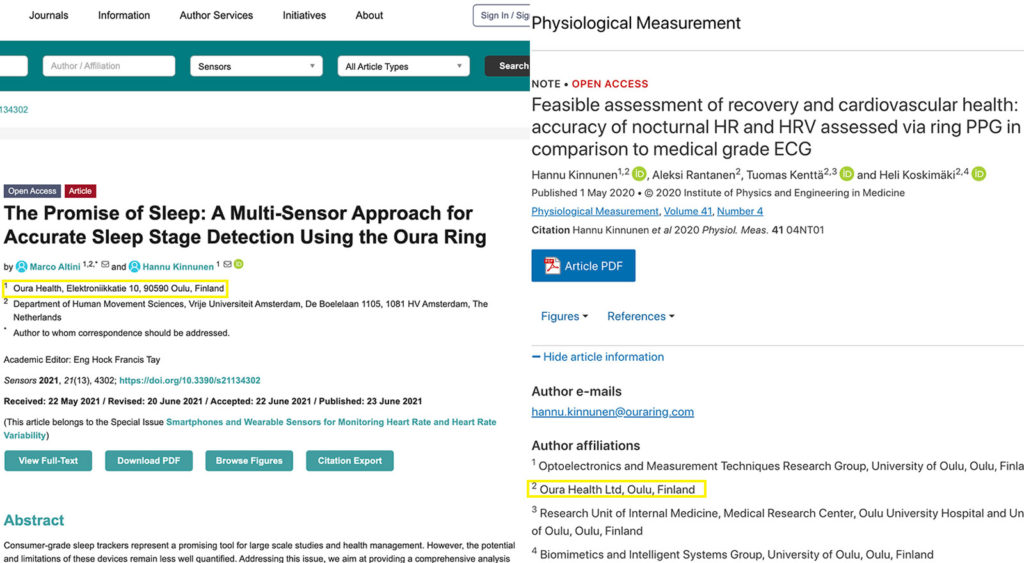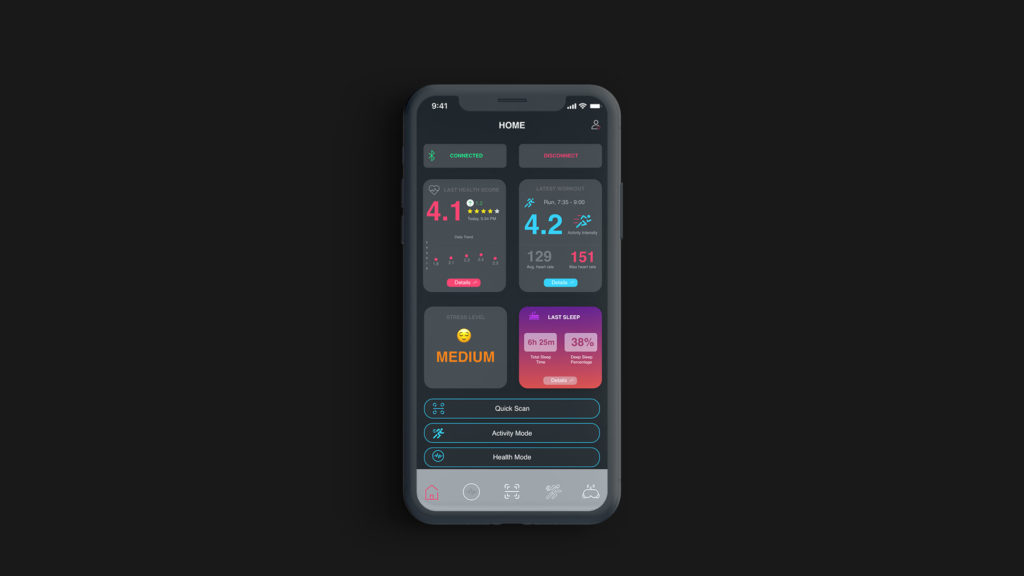2024 is already looking like the peak year for the wearable tech industry. Not only are we seeing hundreds more products, but we’re also seeing better products as pioneer companies begin to perfect their technology. People are beginning to weed out the marketing BS and realize which wearable products are truly the best. Today, we’ll discuss why Oura is more hype than substance, and let you choose the best Oura Ring alternative.
People think that the more products that are out there, the more difficult it is to make a quick decision. But in fact, the cream will always rise to the top. Meaning the best wearable products that have proven themselves over the years will be the ones people go to. However, it’s always a combination of innovation and marketing.
First, I’d like to discuss Oura’s history and how the product works. If you want to skip to the best Oura ring alternative, please do.
OURA’S RISE
It took the company years to get to the level they are at now. I remember participating in the Wearable Technology show more than 8 years ago and their booth was next to ours. They always had a lineup of paid media waiting for press shots. And keep in mind, at that time, their product was hardly usable and not what it is today.
They branded the product as the ‘sleep ring’. It was a tough sell at the time, but all of the spending efforts are paying off. Now they have superstar athletes as paid endorsements. The likes of Chris Paul and Odell Beckham Jr. can be found wearing the Oura ring.

HOW DOES OURA RING WORK
The Oura Ring is a wearable that looks to optimize your health and daily routines using different biomarkers. But in fact, there are only two sensors found inside the device: a BPM sensor, known as a PPG sensor (photoplethysmography) and a temperature sensor. So they’ve even gone away without the accelerometer, which is how other devices track steps, distance, movement, intensity, and more.
And as we’ve talked about in the past, what many companies try to do is take one sensor and recycle the data to show you a bunch of different things. This way, you only need one sensor, but the end user sees a bunch of “different” stuff on the app or watch. This makes sense because the ring is quite small, as compared to an Oura Ring alternative we discuss later. It won’t fit much more than what’s already in there.
The ring connects to your smartphone via Bluetooth and you can see and track all health data via their app. One thing you can say is that they have a very visually appealing app. As the product is a bit low on features, the app needs to be at 100%
OURA RING FEATURES
The main features they list are daytime heart rate, workout HR, period prediction and guided audio and videos. So, 2 of those come from the PPG sensor, and another isn’t even part of the product. They realize that content is, and always will be king. So they are spending effort on creating videos, sounds for meditation, exercises, etc. to keep up with the game. That’s never a good sign.
OURA HRV
Initially, HRV was prominently featured on their front page, but that changed for some reason.
Heart rate variability (HRV) is the single most important biomarker consumers have at their disposal today. It’s tough to find, but there are a handful of products that do it quite well.
Heart rate variability is the only true indicator that we have today of stress levels, resilience and overall health. It measures the time difference between each successive heart beats, in milliseconds. A high HRV means heart rate is changing frequently, which is a good thing. As opposed to a heart rate that acts like a metronome.
We have discussed HRV in depth many times, if you’re interested, click here.
OURA RING ACCURACY
The main thing to note is that there is no real HRV sensor. You can acquire and HRV from either a PPG sensor (like Oura) or an EKG (like the AIO Smart Sleeve). The difference is quite significant. Typical EKG’s are up to 10 times more accurate for heart rate variability readings than a PPG.
For other features, Oura claims their product is more accurate for heart rate monitoring than wrist-based wearables. According to the company, it’s because the fingers are closer to an artery that the wrist so it’s able to get a more accurate signal of blood flow. We have long lobbied against the use of wrist-based wearables due to horrible accuracy, but whether the finger is better is yet to be determined.
PHONEY STUDIES

If you look for validation studies for Oura, there are many studies that are funded by Oura. Or even worse, they are directly involved in the study and are featured as authors. If you search in Google Scholar, the first two “studies” regarding Oura Ring’s accuracy are co-written by Oura Health Ltd. Another big part of their marketing campaign.
OURA RING PROBLEMS
You will never find a perfect product. Even we don’t think our product is the best for everyone. But that’s okay. But there are a couple of important issues with the Oura ring you need to consider before buying it.
OURA RING FOR FITNESS
We can all agree that you’re not going to work out wearing a ring. Yes, you can run and bike without it getting in the way, but if you’re thinking about picking up weights then forget about it. The ring is $400 last time I checked. So I wouldn’t want to be scratching it up on free weights.
For many of Oura ring’s customers, this isn’t a problem since most of the features aren’t workout related. But we believe fitness and activity are crucial to one’s health. And the ability to track and monitor your vitals during workouts is key.
OURA RING BATTERY LIFE
We have a saying: if there’s a battery in it, it will always be a problem. From phones to laptops to cars, everyone complains about the battery life and Oura is no different. It has a 15 mAh battery inside, which is quite small for a health device. When a device is transferring health data from a device to a smartphone, it uses a lot of batter power. To get around this, the device is programmed to collect data less frequently. So instead of every minute, it might be every 5 or 10 minutes. And that’s exactly how Oura gets around their battery issues.
Is this a bad thing? Depends. But you aren’t getting precise data. They say battery life is 4-7 days. But this is at a reduced capacity. If you were using it a fair amount, you’d be lucky to get a day out of it.
OURA RING COMPETITORS
imitation is the sincerest form of flattery, right? No matter which industry you analyze, whether it’s cars, smartphones, cameras, toothbrushes, etc., it’s a copycat game. This is not necessarily a bad thing. If one company does something that works, it means consumers value it. The goal of any company is to make the customers life easier. So, all companies in an industry conduct research and implement what they think is the best solution.
In the wearable technology space, it’s all about how you angle your product. Oura started out as an HRV device, and now its promotion is heavy on the sleep feature. One of their big competitors, WHOOP, also does HRV but they have a different target market. Oura ring competitors aren’t necessarily trying to copy what they do. It’s all about using the features people like and then developing a health application in your own unique way. From companies like KOMODO, EliteHRV, and Bioheart, they all have their own strengths and weaknesses.
BEST OURA RING ALTERNATIVE IN 2023
There are many products like Oura Ring out there. And when it comes to true health insight and improvement, there are some that are much better than Oura. We’ve hand-picked a few and here they are.
UPMOOD

Since heart rate variability is the most important, and valuable consumer biomarker that we have, we had to talk about this company. Upmood is the first live emotion detection wearable and app. Sounds like it’s too good to be true, but in it’s not the case.
Upmood is a bracelet with an integrated PPG sensor with heart rate variability monitoring capabilities. They also just recently released the Upmood watch given the success of their first version. The Upmood wearables connect to your smartphone via Bluetooth and you can see all of the stats from there.
HRV can be a bit of a complex topic and there are many different ways you can dress it up. WHOOP, for example, uses the terms recovery and strain. KOMODO uses stress level and Upmood uses emotion and mood.
Heart rate variability gives us a unique insight into your autonomic nervous system. You might know it as fight-or-flight responses. These responses have a significant effect on stress level and mood. A high HRV is good, which will correlate with a good mood. A low HRV is bad and will correlate with a worse mood.
Upmood helps you better understand your own body and when these mood changes occur. It helps you track and become mindful of what’s going on inside your body. This way, you can optimize your daily routine, reduce the harm on your body and improve your overall health.
Upmood starts at the very low price of $99.99 USD and is considered the HRV wearable king on the Asian market.
AIO SMART SLEEVE by KOMODO TECHNOLOGIES

The AIO (All-In-One) Smart Sleeve is the world’s first Smart compression sleeve. The sleeve itself is made from a proprietary blend that’s unlike any piece of clothing you’ve seen or felt. It’s soft, breathable, stretchy and offers an optimal amount of compression. The AIO Device connects to the inside of the sleeve and connects to Android and iOS apps via Bluetooth as well.
The reason for the compression is for improved accuracy. Think about wrist-based wearables. You will not tie the bracelet or watch too tight on your wrist because you want to be able to move your wrist around and not cut off blood circulation to your band. This creates an air gap between the device and your skin. At the same time, while it’s slightly loose, when you move your hand around during the day it will also lose contact with your wrist.
This creates a great amount of inaccuracy and false reading, as we’ve talked about many times before. With the AIO Smart Sleeve, the compression keeps the device on the wrist and there’s no bracelet that causes any discomfort.
The reason it’s called “All-In-One” is because it is an ultimate, 24-hour device and is loaded with features. Monitor your workouts and recovery, your true sleep quality, stress levels, morning readiness and even food sensitivities.

The biggest game-changer that the AIO Sleeve provides its heart rate variability feature. It’s the only wearable that uses EKG-based HRV monitoring. We discussed earlier the importance of that given the improved accuracy. And the way KOMODO uses an HRV score is different than other products. While many use a percentage scale or milliseconds (which, by the way is horrible and confusing) the AIO Sleeve shows a score based on the 5-star system.
The app is very unique as well. With different ‘events’ set up in the HRV portion of the app, you can see detailed stress level and immune responses throughout the day. The app looks to detect stressors throughout your day. These stressors can be from over exercise, high stress, poor food choices, lack of sleep, and many other factors. By choosing the appropriate ‘event’ in the app, you can then view in the history tab how your stress is trending throughout the day.
EMPATICA E4 WRISTBAND

The reason the prior two wearables are so great is because it’s rare to see good HRV monitors on the consumer market. Because at the end of the day, it’s not good until it’s available for consumers. And this company is trying to bring their clinically tested wearable to more consumers.
While there’s not HRV feature, the Empatica E4 has what’s called an EDA sensor. In short, it detects sweat based on skin conductivity. It’s another way to gauge stress, although not 100% clinically proven yet. We talked about this at length here.
Empatica also collects physiological data in order for you to optimize daily routine and reduce stress. While the Empatica E4 costs a whopping $1,690 USD, they have 2 new products coming out that are more consumer friendly (the Embrace 2 and the Embrace Plus). Hopefully the reduced price doesn’t mean reduced quality.
IS THE OURA RING WORTH IT?
It’s the million-dollar question, and the answer is: No. For the price of $400 there are much better options out there. The truth is, you can only fit so much into such a small wearable. There’s almost nothing in it, and don’t look for them to add anything in there in the future. They really have no future unless they make new products. 80% of their spending is on market and that doesn’t leave much for R&D and product improvement.
Much like Apple, Oura has a great brand and a fan base. They will always be able to sell. But can they improve your life? Given the lack of meaningful features, the answer is: no. However, you should still be encouraged by the amazing innovations out there that CAN in fact change your life for the better. Try an Oura ring alternative today 😉


Oura Ring was good in the first generation. So I bought the 3rd generation and it sucks. For the price I don’t expect to pay then a monthly fee to use the ring. It doesn’t pick up the naps like they say and now they have to algorithms that read the sleep results that are completely different. DO NOT BUY OURA!!!